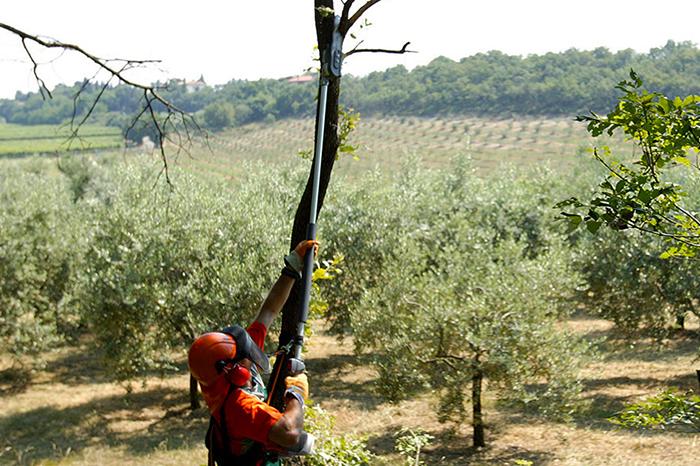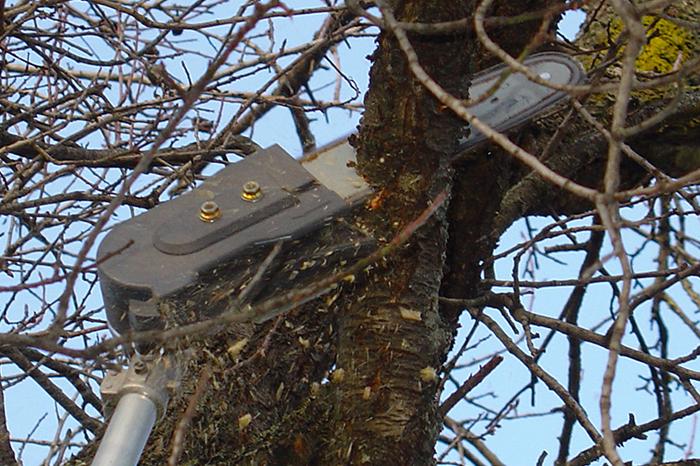How a pruner works

The telescopic pruner is a very useful gardening tool for both enthusiastic amateurs and professional landscapers alike. For example, the Efco PTX 2710 professional telescopic pruner with 1 kW petrol engine is ergonomic, extendible to 3.8 m, and makes your job easier thanks to the 25 cm blade—with five adjustable positions from 0 to 90°—and 21 cm cutting length.
If you want to prune, thin out, shape and trim the tops of tall trees, or if you need to remove dead, broken or diseased branches, a telescopic pruner is an invaluable aid, enabling you to cut high limbs while standing safely on the ground, without having to balance on an unsteady stepladder. You also need a pruner for long-reach cutting, such as when tending wide hedges or reaching over obstacles.
Telescopic pruners belong to a large product family that includes telescopic tree pruners, pole loppers, telescopic saws, telescopic shears and, for the most intricate tasks, telescopic scissors. In this article we want to tell you how to operate petrol-powered telescopic pruners such as the PTX 2710, because this type of tool enables you to work on every type of plant more efficiently and safely than using manual pruners, saving you time and effort.
Petrol telescopic pruners: construction and operation
As you know, there are three basic components in a telescopic pruner:
- Engine: this is the heart of the pruner, for example the PTX 2710 incorporates a two-stroke engine that runs on petrol/oil mixture.
- Telescopic transmission shaft: this is the tube that connects the engine to the cutting part of the machine.
- Cutting tool: this is the top end, which includes a blade and chain.
We will come back to the engine in more detail in the next paragraph, which talks about starting telescopic pruners. Here we focus on preliminary operations. Once you have bought a petrol-powered pruner, the first thing you need to do is connect the two-stroke engine to the transmission shaft:
- Apply grease to the end of the shaft.
- Insert it into the engine shank.
- Insert the corrugated sheath with the electrical cables into the rubber eyelet attached to the outside of the shank.
- Insert the shaft into the shank as far as the stop.
- Tighten the clamp to a torque of 4.0±5.0 N‧m using a screwdriver.
Now connect the transmission shaft to the cutting tool:
- Insert the shaft into the cutting tool until the respective centring holes are aligned.
- Fasten the centring screw, followed by the other cutting tool screws.
- Adjust the chain tension using the chain tensioner screw.
The chain is correctly tensioned if you can pull it upwards a few millimetres (about 4 mm). When handling the pruner chain, always wear protective gloves.
Finally, connect the electric cables on the transmission shaft to the two-stroke engine of your petrol-powered pruner by following the steps below:
- Remove the engine air filter cover.
- Position the corrugated sheath with the electric cables in the appropriate housing.
- Insert all the electrical cables in the respective guides.
- Secure the cable clamp without tightening the screws completely, to keep the cables in position.
- Connect the ground cables to the engine.
- Attach the throttle cable to the carburettor.
- Tighten the screws of the cable clamp to 1.0–1.5 N‧m using the screwdriver.
Close the air filter cover.




Petrol engine telescopic pruners: how to start them
Before starting the engine of your petrol-powered pruner, check the fuel level and, if necessary, add fuel. In the case of two-stroke engines—like that of the Efco PTX 2710 telescopic pruner—prepare the mixture following the instructions on the bottle of two-stroke engine oil. With Efco oil for engines, for example, the correct percentage of oil to petrol is 2%, which means you add 2 cl of oil per 1 litre of petrol.
When you refuel the pruner, also top up the chain oil tank on the cutting tool: lubrication minimises friction between chain and bar, ensuring a longer life for both components.
Also, before starting the engine, check that the chain is correctly tensioned and that no foreign bodies are caught between the teeth and links.


To start the petrol pruner, follow these steps, which should only be performed on a cold engine:
- Operate the on/off switch.
- Push the primer 4 times to fill the carburettor with mixture.
- Set the starter (air lever) to the "Close" position.
- Press the throttle trigger and lock it at half-throttle using the appropriate button (then release the trigger).
- Place the pruner on the ground in a stable position.
- Make sure the cutting tool is free.
- Hold the pruner firmly and pull the starter cord no more than three times, until you hear the engine fire for the first time (a new pruner may require extra pulls).
- Set the starter to the "Open" position.
- Pull the cord again and start the engine.
- Warm up the engine for a few seconds without using the throttle.
- Unlock the half-throttle setting by pressing the throttle: you are now ready to work.
When you have finished cutting with the telescopic pruner, release the throttle trigger to the idle position and wait a few seconds for the engine to cool down, then close the on/off switch to turn off the engine.
What’s the best way to organise your work area when pruning trees? What precautions should you take to ensure safe cutting? And what are the right techniques for cutting with a telescopic pruner? We discuss all this in our blog article how and when to use a telescopic pruner.



